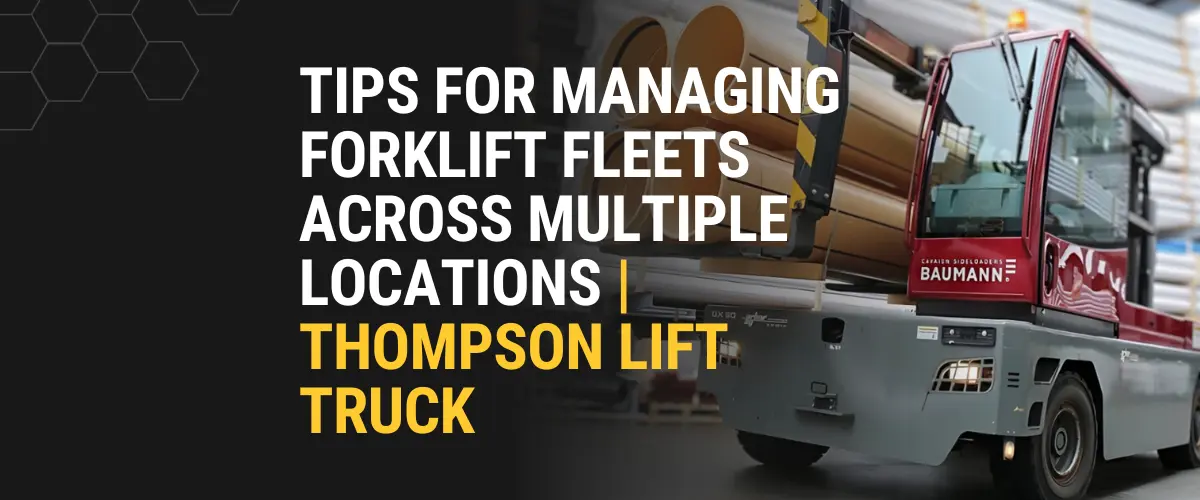
Tips for Managing Forklift Fleets Across Multiple Locations
Quick Facts: Multi-Location Fleet Management
- Tracking usage across sites helps reduce idle equipment and downtime.
- Centralized data shows which forklifts are underused or need maintenance.
- Shared maintenance programs cut costs and improve uptime.
- Telematics make it easier to monitor operator behavior and battery health.
- Standardizing models and service partners simplifies fleet planning.
- Working with one fleet management provider ensures consistency everywhere.
Summary
If you’ve ever tried to keep track of forklifts across different warehouses, you already know it can get messy. Every site has its own pace, its own crew, and its own way of doing things. Before long, you’ve got half the fleet overworked and the other half collecting dust.
That’s what connected fleet management is for. It’s not just another layer of software. It’s a way to see what’s really going on: all your forklifts, all your sites, one clear picture.
The Challenge of Multi-Site Fleets
Here’s what usually happens. A company starts small, one location, everything runs fine. Then the business grows. You add another site, maybe a few hundred miles away. Pretty soon, someone’s calling to say they need more forklifts, while another location has three sitting unused.
Without shared data, nobody’s sure which machines need service, which ones are down, or which are being pushed too hard. It’s nobody’s fault; it’s just what happens when information lives in silos.
Bring the Data Together
Step one is simple: connect everything. Doesn’t matter what brand of forklifts you’ve got or where they’re sitting, just get all that information into one system.
Once that’s done, you can see the patterns. Maybe one branch racks up hours faster because they run double shifts. Maybe another keeps missing tire rotations. These little things add up over time. When you see it all in one place, you can fix it before it costs you.
Fleet management platforms like Thompson Lift Truck’s system help centralize data across locations, giving you clear insights into performance and maintenance.
Spot the Gaps and Share the Load
A lot of managers don’t realize how uneven fleet usage can get. One warehouse might be logging twice as many hours as another. Sometimes it’s just scheduling; sometimes it’s layout.
We’ve seen companies move a few forklifts from slower sites to busier ones and immediately save on overtime and rentals. The data tells you where to shift the load, literally and financially.
Keep Maintenance Consistent
When each facility handles service on its own, chaos follows. Different suppliers, different intervals, different paperwork. One site logs an oil change; another forgets.
Centralized maintenance puts everyone on the same plan. You know when each forklift was last serviced, what was replaced, and what’s due next. Fewer breakdowns, fewer surprises, better budgets. It’s boring in the best possible way.
Thompson Lift Truck’s Service and Maintenance programs can be tailored to cover multiple locations under one consistent schedule.
Telematics: Your Eyes at Every Site
Telematics might sound complicated, but it’s really just about knowing what’s happening when you’re not there. You can check battery levels, fault codes, and even driving habits from your desk.
That’s not about micromanaging, it’s about staying ahead of problems. A warning light today is one less emergency tomorrow. And when operators know their performance is visible, safety tends to improve without extra meetings or memos.
Explore how forklift telematics can improve uptime and visibility across your fleet.
Make It the Same Everywhere
Every warehouse has its quirks, that’s fine. But processes should look the same no matter where you are. The same maintenance rules, the same reporting format, the same contact for service calls.
Once that’s in place, things just run smoother. You can move forklifts between sites without confusion, train new staff faster, and keep everyone working off the same playbook.
Conclusion
Managing a fleet across several locations isn’t about being everywhere at once, it’s about having the information that lets you act before something breaks. Centralized data and consistent maintenance aren’t flashy, but they save money and headaches.
That’s what Thompson Lift Truck’s fleet management solutions are built for: one system, one set of standards, all your forklifts in sync. When your data’s connected, your whole operation just runs better.
FAQs: Forklift Fleet Management
How do I keep track of forklifts in different states?
Use a shared fleet dashboard. It logs usage, service, and maintenance for every forklift, no matter where it’s located.
What’s the fastest way to reduce forklift downtime when managing multiple fleets?
Stick to one maintenance schedule across all sites. When everyone follows the same plan, you don’t lose time chasing records or waiting on parts.
How does forklift telematics help reduce equipment downtime?
Yes. Telematics lets you catch issues early and plan service around data, not guesswork. Most businesses see fewer breakdowns within months.
How can Thompson Lift Truck help with forklift fleet management?
Thompson offers fleet management systems that bring every site under one plan. Less admin, fewer delays, and better performance across the board.

